WORLD CLASS COACHING
Developing Soccer Intelligence Through 4v4 Vol 2
By Philip Cauchi
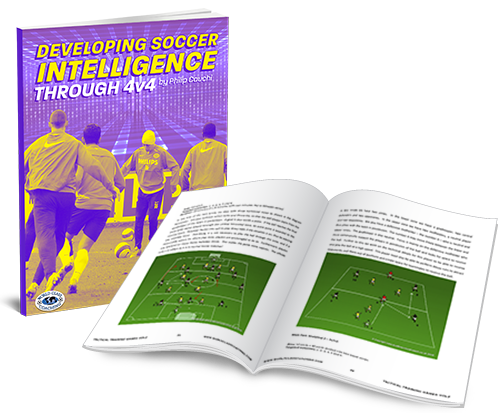
Table of Contents
PART THREE
Progressive Sessions
Progressive Sessions
Session number: 7.
Moment of the game: Opponents in possession.
Team task: Deny the build-up.
Aim: Prevent the opponents from playing line-breaking passes.
Technical-tactical outcomes:
1. Remain compact.
2. Cut off forward passing lanes.
3. First defender applies pressure on the ball.
4. Nearby defenders cover and mark potential receivers.
5. Make play predictable.
6. Move together as a group.
Duration of session: 90 minutes.
Number of players: 12 players.
Equipment:
Balls (at least four).
Bibs (one set of four bibs).
Markers (two sets of a different colour).
Mini goals (four).
Session plan:
Movement preparation and coordination: 15 minutes.
Principles of defending – 4v2 prevent the split pass: 10 minutes.
Game 1 – 2v2 with quick turnovers: 15 minutes.
Group defending practice – 2v2 recovery defending: 10 minutes.
Game 2 – Six goal game: 15 minutes.
Game 3 – 4v4+GKs: 25 minutes.
Movement preparation and coordination.
1. Multi-lateral footwork – 5 minutes.
2. Dynamic flexibility and mobility – 5 minutes.
3. Reactive speed with five meter sprints – 5 minutes (2 sets x 6 reps).
Principles of defending – 4v2 prevent the split pass.
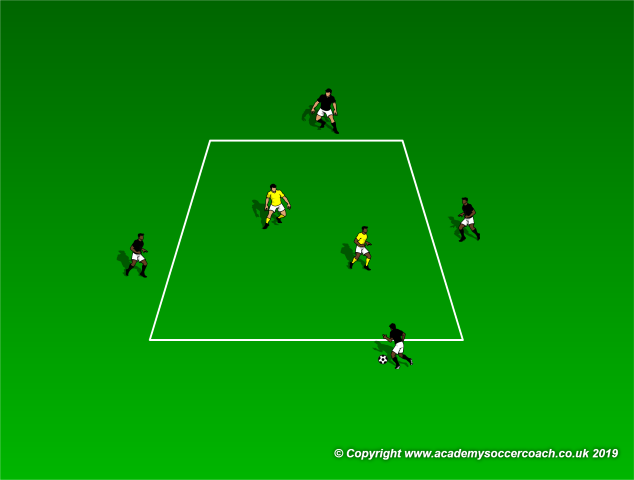
Remind players to focus on: 1) remaining compact, 2) making play predictable and 3) moving together as a group.
Area: 12 yards by 12 yards.
Players: Four attackers and two defenders.
Duration: 10 minutes.
Description: The attackers aim to make eight consecutive passes to score a point or play a splitting pass to score two points. If the defenders win the ball, they play 2v1 against an attacker on a particular line, scoring by dribbling the ball out of the area.
Game 1 – 2v2 with quick turnovers.
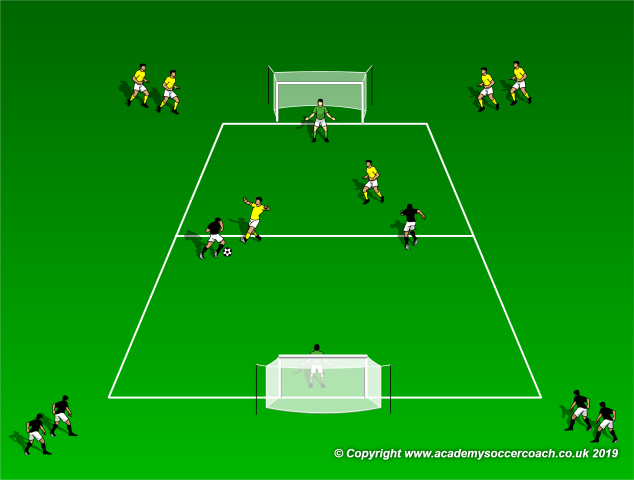
Remind players to focus on: 1) remaining compact, 2) moving together as a group and 3) forcing play away from goal.
Area: 20 yards in length x 15 yards in width divided into two equal horizontal zones.
Players: Two players from each team playing the 2v2 plus a goalkeeper in each goal. The other players from each team rest.
Duration: 15 minutes.
Workload: 4 x 3 minutes with one minute rest between series.
Description: Both teams aim to score in the opponents’ goal. If a goal is scored from inside the offensive half it counts double the points. Both teams should thus work on a strategy to limit the opponents from getting inside their defensive half. Furthermore, players have to work in cooperation to reduce the time and space of the opponents to finish at goal especially when they are inside their defensive half. When the ball goes out of play, two new players for each team step into the pitch to initiate a new 2v2. Have one team always starting the action and then change in the next series.
Group defending practice – 2v2 recovery defending.
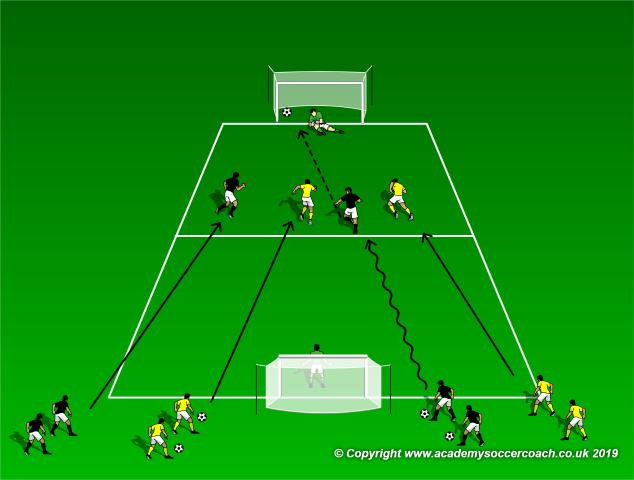
Remind players to focus on: tracking back quickly while reducing the time and space of the attacker on the ball.
Area: 20 yards in length by 15 yards in width divided into two equal horizontal zones.
Players: Two sets of players for each team positioned on one end line of the pitch as shown in the above image. In each team one of the players (the middle ones) have a ball.
Duration: 10 minutes.
Workload: 2 sets of 6 reps with three minutes rest in between sets.
Description: One team attacks while the other defends. Goals only count if scored from inside the attacking half of the pitch. If the defending team wins the ball they counter on the opposite goal.
Progression: Coach shows using a marker or any type of visual stimulus to indicate the team that will attack. The other team automatically defends.
Game 2 – Six goal game.
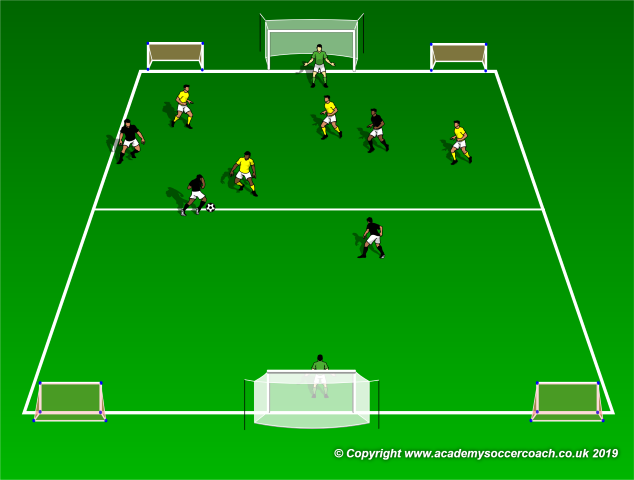
Remind players to focus on: 1) retaining compactness and 2) mark potential receivers of the ball.
Area: 40 yards in length by 30 yards in width divided into two equal horizontal zones. A regular goal and two mini goals are positioned at each end line as shown in the above image.
Players: Two teams of four players plus a goalkeeper. The other four players play a 2v2 line soccer game and then rotate with a team playing in this game.
Duration: 15 minutes.
Workload: 4 sets of 3 minutes with one minute rest in between sets.
Description: Both teams defend two mini goals and a regular goal which are situated on one end line while attacking the opposite. Teams may score in the regular goal which equals to two points or in the mini goals which equal to one point. This situation forces the players to cooperate more in the defensive phase to eliminate the space the opponents require to manoeuvre the ball and create scoring chances.
Game 3 – 4v4+GKs.
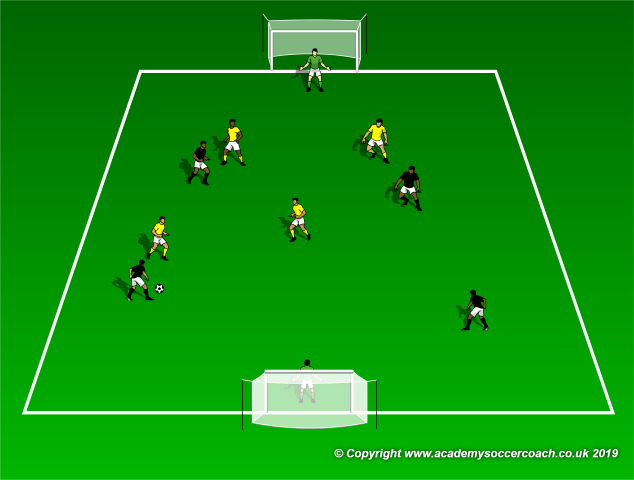
Remind players to focus on: 1) retaining compactness and 2) mark potential receivers of the ball.
Area: 40 yards in length by 30 yards in width with a regular goal positioned at each end line.
Players: Two teams composed of four players plus a goalkeeper. The other four players perform passing exercises. Teams rotate after each set.
Duration: 25 minutes.
Workload: 3 sets of 6 minutes with two minutes rest in between sets.
Description: Normal game where each team defends one goal and attacks the opposite.
Session number: 8.
Moment of the game: In possession.
Team task: Build-up.
Aim: Create passing angles and support.
Technical-tactical outcomes:
1. Staggered angles.
2. Open body stance to receive the ball.
3. Quality of passing.
4. Moving into passing lanes.
Duration of session: 75 minutes.
Number of players: 12 outfield players and no goalkeepers.
Equipment:
Balls (at least four).
Mini goals (at least one, but two highly recommended for a better flow of practice).
Bibs (four).
Markers. (Three sets of four colours each as per the first activity where we have three setups).
Session plan:
Movement preparation: 15 minutes.
Technical-tactical activation – Create passing angles within a diamond: 10 minutes.
Passing practice – Combine with the inside player: 10 minutes.
Passing practice – 3v1 in a triangle: 10 minutes.
Game – 4v4 on retracted mini goals: 30 minutes.
Movement preparation and coordination.
1. Footwork using the agility ladder interspersed with dynamic flexibility – 10 minutes.
2. Reaction speed with short sprints of five meters – 5 minutes.
Technical-tactical activation – Create passing angles within a diamond.
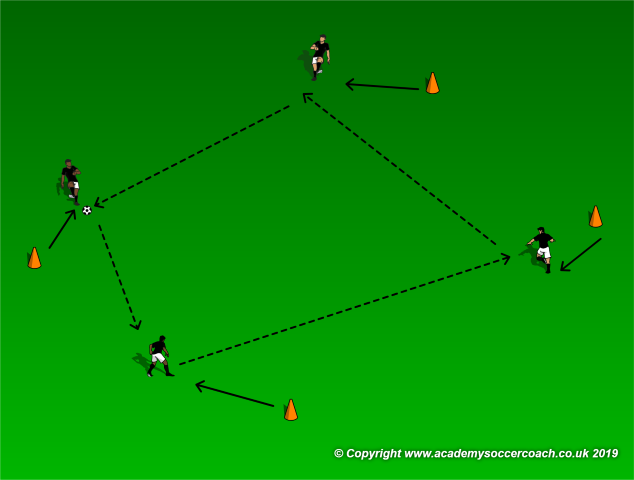
Remind players to focus on: 1) moving to offer a passing angle, 2) adapt an open body stance to receive the ball and 3) pass the ball with speed and accuracy on the ground.
Area: Have three setups each measuring approximately 15 yards by 15 yards.
Players: Four players, one at each cone.
Duration: 10 minutes.
Description: Players may pass to any other player within the diamond formation. Players must not remain static but must move away from the marker to create an angle as if to lose the defender and receive the ball in the space created.
Progression: Players aim to pass within two touches. This requires them to adapt the correct stance to receive, apply a direction oriented first touch and execute an accurate pass.
Passing practice – Combine with the inside player.
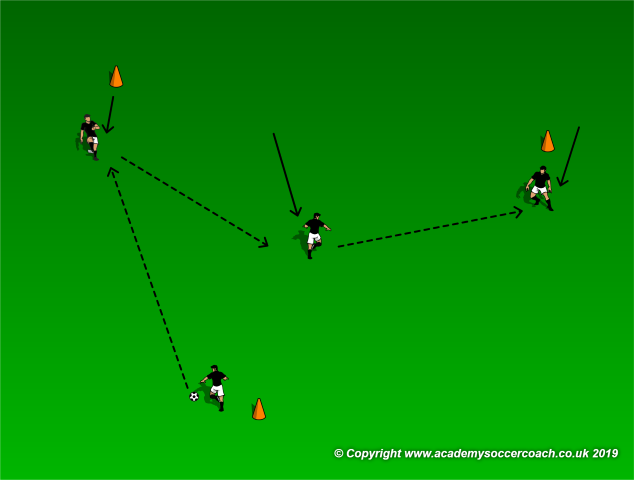
Remind players to focus on: 1) creating passing angles, 2) adapt an open body stance to receive the ball and 3) pass the ball with speed and accuracy on the ground.
Area: Have three setups each measuring approximately 12 yards by 12 yards.
Players: Four players, three at a cone and another player roaming inside.
Duration: 10 minutes.
Description: Players are free to combine with any other player. Players must move at angles to each other with the inside player acting as a pivot. Encourage players to be creative in their passing by playing one-twos or bypassing the pivot player by having the latter performing dummy runs.
Progression: The pivot player may move to a marker which acts as a trigger for the player positioned at that marker to move inside and perform a rotation.
Passing practice – 3v1 in a triangle.
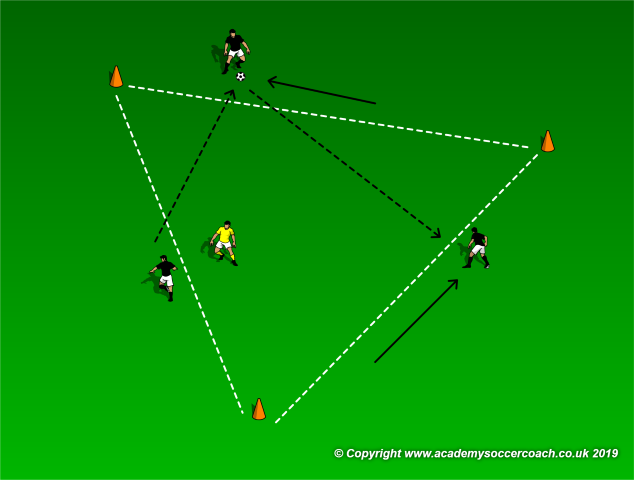
Remind players to focus on: 1) moving to offer a passing option, 2) adapting an open body stance to receive the ball and 3) passing the ball with speed and accuracy on the ground.
Area: Have three setups where the sides of the triangular setup measures approximately 12 yards each.
Players: Four players, one attacker at each side of the triangle and a defender inside.
Duration: 10 minutes.
Description: The three attackers combine with each other to keep possession of the ball against the defender. If the defender wins the ball, he tries to dribble it out of the triangle by playing a 1v1 with the player positioned on that side.
Progression: Decrease the area of the triangle by reducing each side to 10 yards.
Passing practice – 2v1 to 2v1 combining with the pivot player.
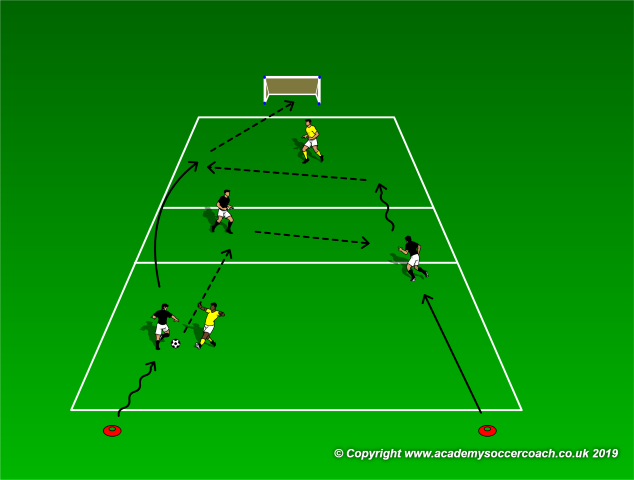
Remind players to focus on: 1) moving to offer passing options, 2) adapting an open body stance to receive the ball and 3) passing the ball with speed and accuracy on the ground.
Area: 20 yards in length by 12 yards in width with a middle channel measuring 3 yards in length. A mini goal is positioned 2 meters behind the end line.
Players: A defender is positioned in each of the lateral zones. An attacking pivot player is positioned inside the horizontal middle channel, while another two attackers (one of them with the ball) start from the red markers.
Duration: 10 minutes.
Description: The two attackers positioned at the red markers start with the ball against the defender positioned in this zone. They aim to combine with the pivot player prior to playing against the defender in the opposite area to score in the mini goal.
Progression: Attackers aim to score within a pre-allotted time limit.
Game – 4v4 on mini goals.
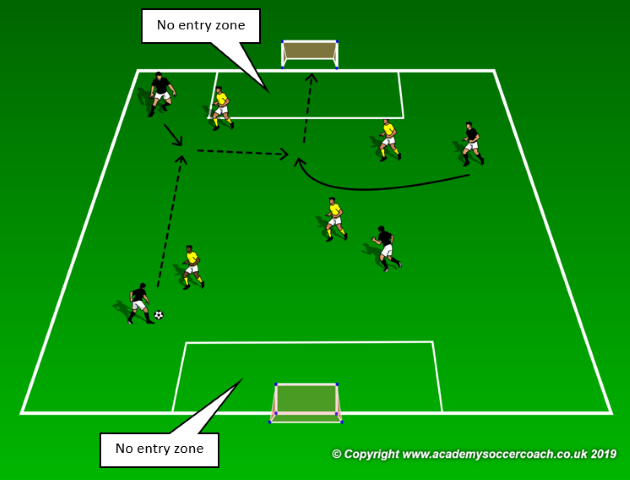
Remind players to focus on: creating passing angles.
Area: 40 yards in length by 30 yards in width with two “no entry” areas marked at each end zone each measuring 5 yards in length by 15 yards in width.
Players: Two teams composed of four players each.
Duration: 30 minutes.
Workload: 4 x 6 minutes interspersed with two minutes rest in between series.
Description: Normal game but no player can enter the no entry zone.
Progression: Attackers aim to score within a pre-allotted time limit.
Session number: 9.
Moment of the game: In possession.
Team task: Build-up.
Aim: Keep possession of the ball in numerical superiority.
Technical-tactical outcomes:
1. Staggered angles.
2. Diamond formation.
3. Quality of passes.
4. Direction oriented first touch.
Duration of session: 78 to 80 minutes.
Number of players: 12 outfield players and no goalkeepers.
Equipment:
Balls (at least four).
Mini goals (two).
Bibs (four).
Markers. (Three sets of four colours each as per the first activity where we have three setups).
Session plan:
Movement activation: 15 minutes.
Technical-tactical activation – Passing through the defence: 10 minutes.
Passing practice – Four square 4v2 rondo: 15 minutes.
Analytical 2 – Four square 4v2 rondo: 15 minutes.
Analytical 3 – 4v2 on two retracted mini goals: 15 minutes.
Game – 4v4 on two retracted mini goals: 18 minutes.
Movement preparation and coordination.
1. Footwork using the agility ladder – 10 minutes.
2. Capacity of equilibrium – 5 minutes.
Technical-tactical activation – Passing through the defence.
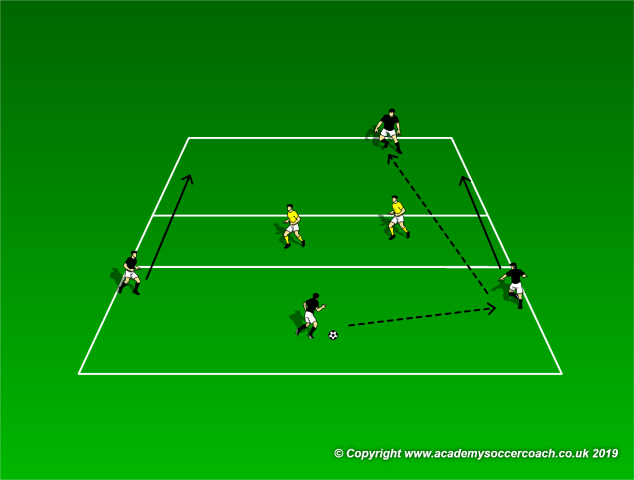
Remind players to focus on: 1) creating passing angles, 2) adapting an open body stance and 3) passing with the correct accuracy and weight.
Area: Area measuring 15 yards in length by 10 yards in width with a 4 yard channel in the middle.
Players: Three attackers are situated on one side while another is situated on the opposite side. Two defenders roam the middle channel.
Duration: 12 minutes.
Description: Play starts from the side where there are three attackers. The three attackers aim to pass the ball to their teammate on the opposite side through the middle channel. If the ball is successfully played to the opposite side, two attackers follow to provide support and passing options to the receiver. The 3v2 situation is again recreated.
Passing practice – Four square 4v2 rondo.
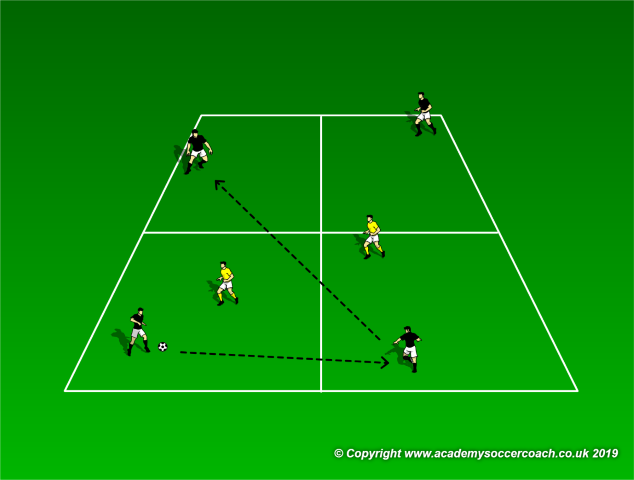
Remind players to focus on: 1) creating passing angles and 2) passing the ball quickly.
Area: Area measuring 12 yards by 12 yards which is divided into four equal zones.
Players: An attacker is positioned in each zone. Two defenders are inside the square but they cannot be in the same zone.
Duration: 15 minutes.
Workload: 2 sets x 6 repetitions of 1 minute with thirty seconds rest in between repetitions and two minutes between sets.
Description: Attackers remain inside their zone and aim to circulate the ball to keep possession. The two defenders try to intercept the ball but cannot be both in the same zone. If the defenders win the ball, the defender who was successful aims to dribble it out of the area against the attacker in that quarter. Rotate defenders between series.
Progression: Reduce the area to 10 yards by 10 yards.
Analytical 3: 4v2 on two retracted mini goals.
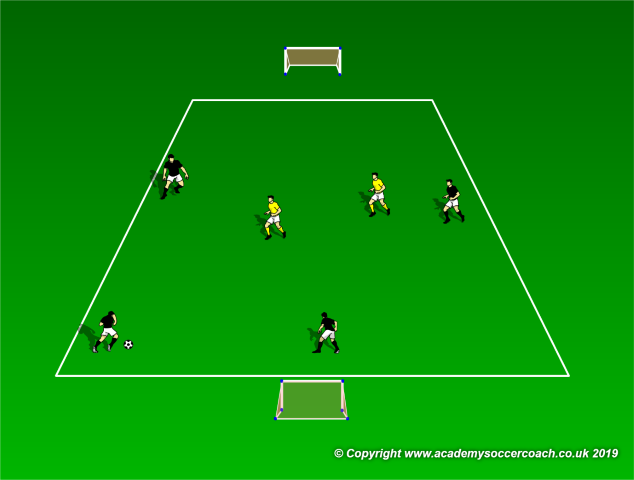
Remind players to focus on: 1) moving into passing lanes and 2) adapting an open body stance to receive the ball.
Area: 15 yards in length by 12 yards in width. A mini goal is positioned two meters beyond each end line.
Players: Four attackers play against two defenders.
Duration: 18 minutes.
Workload: 6 x 2 minutes with one minute rest in between series.
Description: Play always starts from the attacking team’s goal line. The attackers aim to score in the defending team’s goal while the defenders aim to prevent the attackers from scoring and counter in the opposite goal. Rotate the defenders after every set.
Progression: The attackers must score in less than a pre-established amount of time otherwise the defending team scores a point. This progression increases the perception of the players in the attacking team to get into positions quickly to either receive the ball or create space in search of the vertical pass. Angles of support and forward runs will come naturally with this progression.
Game: 4v4 on two retracted mini goals.
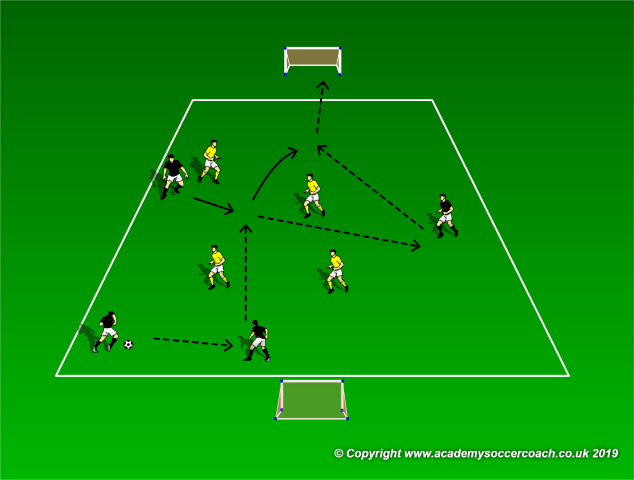
Remind players to focus on: creating staggered angles of support.
Area: Area measuring 40 yards in length by 30 yards in width. A mini goal is positioned two meters beyond each end line.
Setup: Teams play 4v4 with no goalkeepers on retracted mini goals. Third team does a 3v1 rondo.
Workload: Each team plays six games of two minutes each. Therefore we have a total of nine games totalling eighteen minutes. Teams rotate immediately so we have a minimal loss of time.
Description: Normal game where we emphasize the shape of the teams during the attacking phase of play. Do not stop to correct, but rather let the game flow. If players need some kind of feedback this can be given to them in their two minute break between games.


